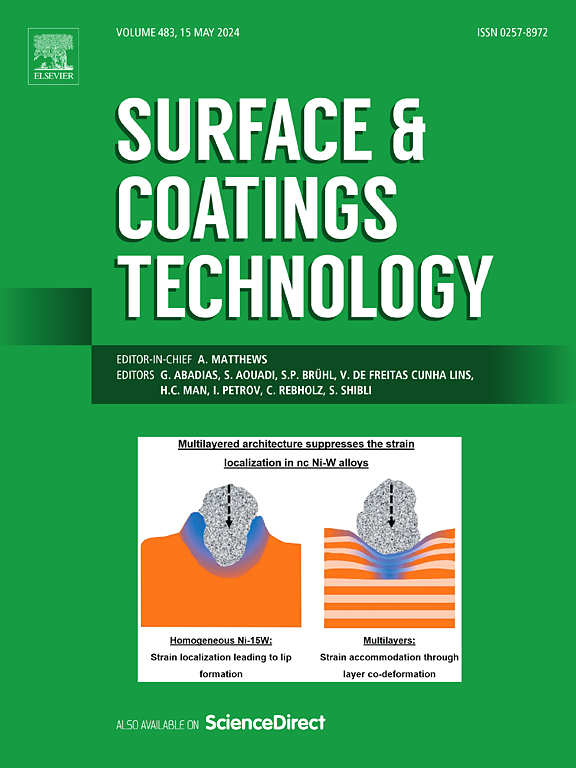Microstructure and properties of laser-cladded TiZrHfNbTaMox RHEA coating on TC4
IF 6.1
2区 材料科学
Q1 MATERIALS SCIENCE, COATINGS & FILMS
引用次数: 0
Abstract
In this paper, Laser cladding was used to deposit TiZrHfNbTaMox RHEA coatings (x = 0, 0.25, 0.5, 0.75, 1) on TC4 substrate to investigate the effect of Mo on their microstructure, hardness, tribological, and corrosion properties. Lamellar microstructural features were identified within the coating, and the formation of twin structures at the coating–substrate interface was observed by TEM; these microstructural characteristics are believed to collectively contribute to the enhancement of the overall performance of the coating. Mo addition notably improves the hardness and wear resistance of the coatings. Especially the TiZrHfNbTaMo0.75 coating exhibits excellent performance under both dry sliding friction wear conditions and a 3.5 wt% NaCl solution corrosion wear conditions. A synergistic effect of oxidation, adhesion, and abrasion is responsible for the friction-corrosion mechanism of Mo-containing coatings. Outstanding corrosion resistance of the TiZrHfNbTaMo1 coating is observed in the 3.5 wt% NaCl solution.
TC4上激光熔覆TiZrHfNbTaMox RHEA涂层的组织与性能
本文采用激光熔覆的方法在TC4基体上沉积TiZrHfNbTaMox RHEA涂层(x = 0, 0.25, 0.5, 0.75, 1),研究Mo对涂层显微组织、硬度、摩擦学和腐蚀性能的影响。在涂层内部发现了层状微观组织特征,透射电镜观察了涂层-基体界面孪晶结构的形成;这些微观结构特征被认为共同有助于提高涂层的整体性能。Mo的加入显著提高了镀层的硬度和耐磨性。特别是TiZrHfNbTaMo0.75涂层在干滑动摩擦磨损条件和3.5 wt% NaCl溶液腐蚀磨损条件下均表现出优异的性能。氧化、粘附和磨损的协同作用是导致含钼涂层摩擦腐蚀机理的原因。在3.5 wt% NaCl溶液中,TiZrHfNbTaMo1涂层具有良好的耐腐蚀性。
本文章由计算机程序翻译,如有差异,请以英文原文为准。
求助全文
约1分钟内获得全文
求助全文
来源期刊

Surface & Coatings Technology
工程技术-材料科学:膜
CiteScore
10.00
自引率
11.10%
发文量
921
审稿时长
19 days
期刊介绍:
Surface and Coatings Technology is an international archival journal publishing scientific papers on significant developments in surface and interface engineering to modify and improve the surface properties of materials for protection in demanding contact conditions or aggressive environments, or for enhanced functional performance. Contributions range from original scientific articles concerned with fundamental and applied aspects of research or direct applications of metallic, inorganic, organic and composite coatings, to invited reviews of current technology in specific areas. Papers submitted to this journal are expected to be in line with the following aspects in processes, and properties/performance:
A. Processes: Physical and chemical vapour deposition techniques, thermal and plasma spraying, surface modification by directed energy techniques such as ion, electron and laser beams, thermo-chemical treatment, wet chemical and electrochemical processes such as plating, sol-gel coating, anodization, plasma electrolytic oxidation, etc., but excluding painting.
B. Properties/performance: friction performance, wear resistance (e.g., abrasion, erosion, fretting, etc), corrosion and oxidation resistance, thermal protection, diffusion resistance, hydrophilicity/hydrophobicity, and properties relevant to smart materials behaviour and enhanced multifunctional performance for environmental, energy and medical applications, but excluding device aspects.
 求助内容:
求助内容: 应助结果提醒方式:
应助结果提醒方式:


